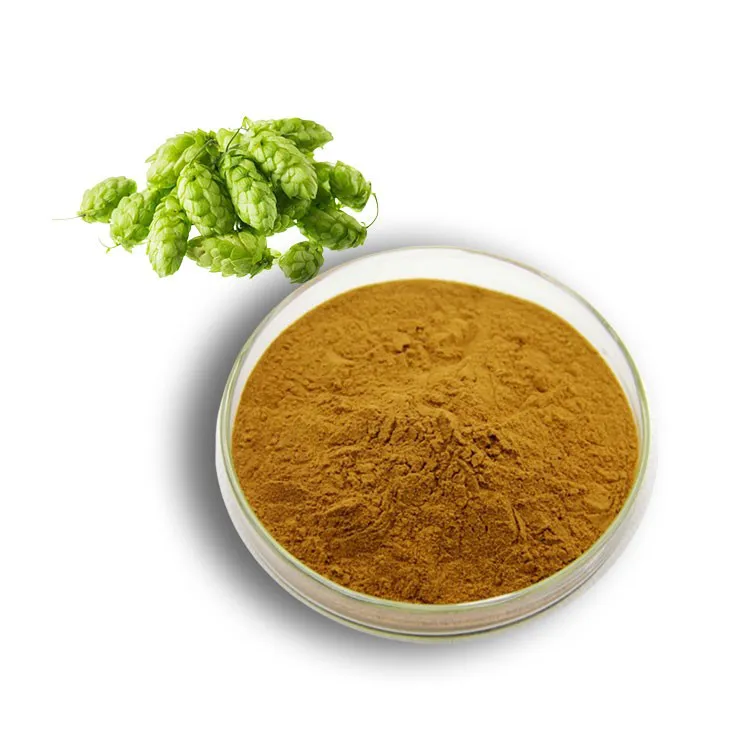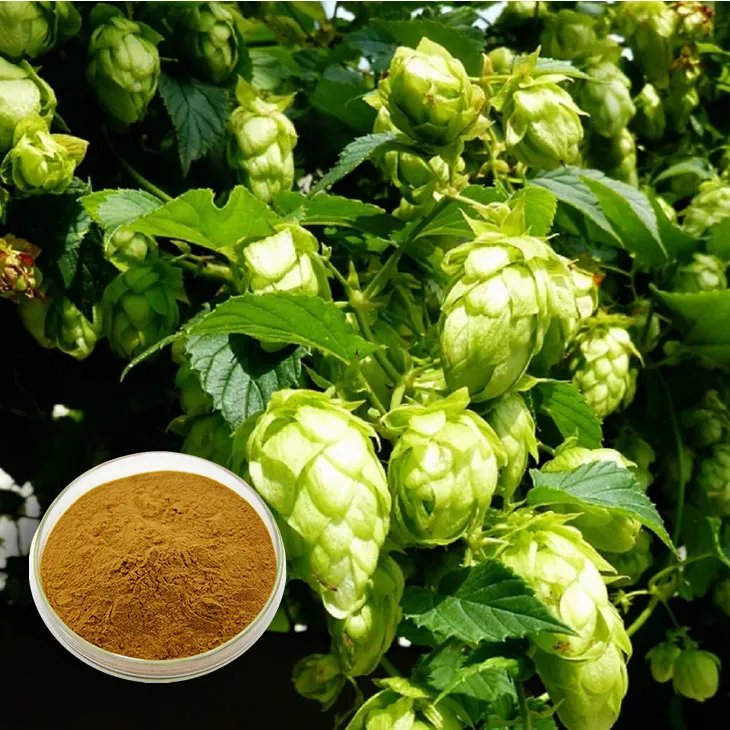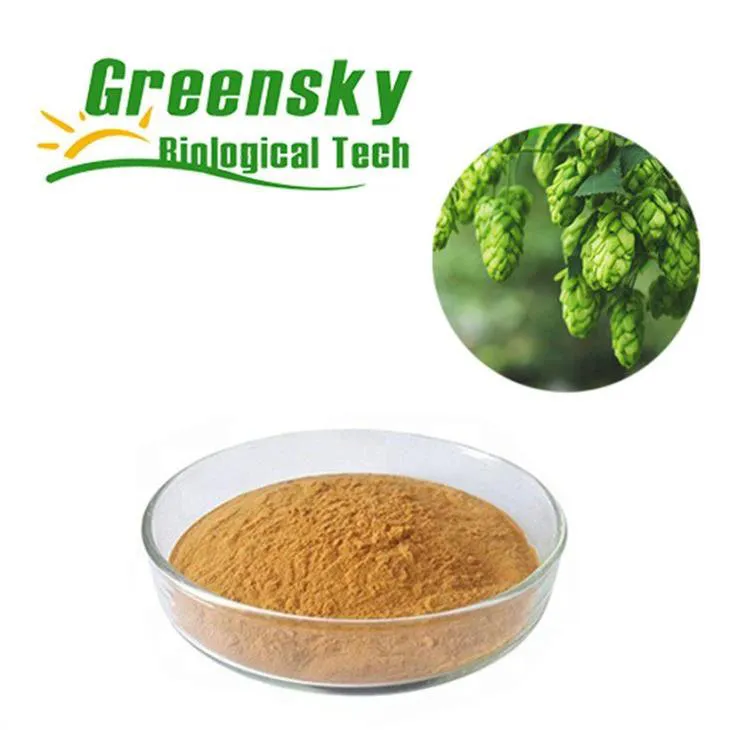- 0086-571-85302990
- sales@greenskybio.com
Extract hops extract by steam distillation.
2024-11-28

Introduction
In the brewing industry, the Hops Extract obtained through steam distillation is of great significance. Hops are a crucial ingredient in beer production, contributing to its flavor, aroma, and stability. Steam distillation is a widely used method for extracting the desirable components from hops. This process has been refined over time to meet the high - quality standards of the brewing world.

Chemical Components Targeted in Steam Distillation
Essential Oils
One of the main components targeted during steam distillation of hops is the essential oils. These oils are responsible for the characteristic aroma of hops. They contain a variety of compounds such as myrcene, humulene, and caryophyllene. Myrcene, for example, has a strong, resinous, and citrus - like aroma. Humulene imparts a more earthy and woody note, while caryophyllene adds a spicy and peppery scent. The extraction of these essential oils is crucial as they contribute significantly to the overall flavor profile of the beer.
Resins
Resins are another important group of compounds in hops. They are mainly responsible for the bitter taste in beer. The alpha - acids and beta - acids present in the resins are of particular interest. Alpha - acids, when isomerized during the brewing process, contribute to the bitterness of the beer. Steam distillation helps in extracting these resins, albeit in a different form compared to traditional brewing methods. This allows for a more controlled addition of bitterness to the beer during the brewing process.
Equipment for Steam Distillation
The Steam Generator
The steam generator is a fundamental part of the steam distillation setup. It is responsible for producing a continuous supply of steam. Modern steam generators are often made of high - quality stainless steel, which can withstand high temperatures and pressures. They are designed to produce steam at a consistent rate and pressure, which is crucial for efficient extraction. The steam produced should be clean and free from contaminants that could affect the quality of the Hops Extract.
The Distillation Column
The distillation column is where the actual separation of the components takes place. It is typically a tall, cylindrical vessel filled with packing material or trays. The packing material or trays increase the surface area available for vapor - liquid contact. This allows for better separation of the different components in the hops. As the steam rises through the column, it carries the volatile components of the hops with it. The different components then condense at different levels in the column depending on their boiling points.
The Condenser
The condenser is used to convert the vaporized components back into liquid form. It is usually a heat exchanger that cools the vapor using either water or air. The design of the condenser is important to ensure efficient cooling and condensation. A well - designed condenser can prevent the loss of volatile components and ensure that the Hops Extract is collected in a concentrated form. There are different types of condensers, such as shell - and - tube condensers and plate condensers, each with their own advantages and disadvantages depending on the scale of operation and the specific requirements of the distillation process.
The Receiver Flask
The receiver flask is where the condensed hops extract is collected. It is important to use a flask that is clean and sterile to prevent contamination of the extract. The size of the receiver flask should be appropriate for the amount of extract expected to be produced. It should also be made of a material that is compatible with the extract, such as glass or certain types of plastics.
Setup for Efficient Extraction
Temperature Control
Temperature plays a crucial role in steam distillation of hops. The steam temperature should be carefully controlled to ensure that the desired components are efficiently extracted without causing thermal degradation. Generally, a steam temperature in the range of 100 - 150 °C is used. However, the exact temperature may vary depending on the specific type of hops and the components being targeted. For example, if the focus is on extracting more volatile essential oils, a lower temperature closer to 100 °C may be more appropriate to prevent their evaporation.
Pressure Regulation
Pressure regulation is also important in the steam distillation setup. Maintaining a consistent pressure helps in controlling the rate of steam flow and the boiling point of the components in the hops. A slight positive pressure is often maintained in the system to ensure that the steam can effectively carry the volatile components through the distillation column. However, excessive pressure can lead to equipment damage and may also affect the quality of the extract.
Feed Rate of Hops
The feed rate of hops into the distillation system needs to be optimized. If the feed rate is too high, the steam may not be able to effectively extract all the desired components, leading to a lower - quality extract. On the other hand, if the feed rate is too low, the process may be inefficient and time - consuming. The optimal feed rate depends on factors such as the capacity of the equipment, the type of hops, and the desired concentration of the extract.Quality Control during and after Extraction
During Extraction
- Monitoring the temperature and pressure continuously is essential during the extraction process. Any sudden changes in these parameters can indicate a problem with the equipment or the process and may lead to a sub - optimal extract.
- Sampling the vapor phase at different levels in the distillation column can provide information about the progress of the extraction. This can help in determining if the desired components are being efficiently separated and carried over by the steam.
After Extraction
- Analysis of the chemical composition of the extract is crucial. This can be done using techniques such as gas chromatography - mass spectrometry (GC - MS). This analysis helps in ensuring that the extract contains the correct proportions of essential oils, resins, and other desired components.
- Testing for contaminants is also necessary. Contaminants such as pesticides, heavy metals, or microbial contaminants can affect the quality and safety of the hops extract. Appropriate testing methods should be employed to detect and quantify these contaminants.
- Storage conditions play an important role in maintaining the quality of the extract. The extract should be stored in a cool, dark, and dry place in appropriate containers. The containers should be airtight to prevent oxidation and degradation of the extract.
Innovation and Improvement in Steam Distillation of Hops Extract
New Equipment Designs
There is continuous research into new equipment designs for steam distillation. For example, some researchers are exploring the use of micro - distillation equipment for small - scale production of high - quality hops extract. These micro - distillation systems can offer more precise control over the distillation process and may be more energy - efficient. Another area of innovation is in the design of the distillation column. New column designs with improved packing materials or tray geometries can enhance the separation efficiency of the components in the hops.
Alternative Energy Sources
The use of alternative energy sources for steam generation is an area of potential improvement. Currently, most steam generators in the brewing industry rely on traditional energy sources such as natural gas or electricity. However, there is potential for using renewable energy sources such as solar - powered steam generators or biomass - fueled boilers. This not only reduces the environmental impact but may also lead to cost savings in the long run.
Process Optimization through Modeling
With the development of computer - based modeling techniques, it is possible to optimize the steam distillation process. By creating mathematical models of the distillation process, it is possible to predict the behavior of the different components in the hops under different operating conditions. This can help in determining the optimal temperature, pressure, and feed rate settings for maximum extraction efficiency. Modeling can also be used to simulate the effect of different equipment designs on the extraction process, allowing for more informed decisions during equipment upgrades or new installations.FAQ:
What are the main chemical components of beer hops targeted in steam distillation?
The main chemical components targeted during steam distillation of beer hops are essential oils. These oils are responsible for much of the aroma and flavor in beer. They contain compounds such as myrcene, humulene, and caryophyllene. Myrcene gives a floral and fruity note, humulene has a characteristic hoppy and earthy aroma, and caryophyllene adds a spicy touch.
What kind of equipment is typically used for steam distilling beer hops extract?
Typically, a steam distillation apparatus consists of a still, which is the main container where the hops are placed. There is also a steam generator to produce the steam. A condenser is used to cool down the vapor produced during distillation so that it can be collected as a liquid extract. Additionally, there are connecting tubes to ensure the proper flow of steam and the distilled product. The equipment is often made of stainless steel to avoid any unwanted reactions with the hops or the extract.
How is the steam distillation equipment set up for efficient extraction?
For efficient extraction, the steam generator is connected to the still in such a way that the steam can evenly distribute through the hops. The still should be designed to allow good contact between the steam and the hops. The condenser is set up with a proper cooling system, usually using cold water, to quickly cool the vapor. The flow rate of steam is also carefully controlled. If the steam flow is too fast, it may not allow sufficient time for the essential oils to be vaporized and carried over. If it is too slow, the extraction process will be time - consuming.
What are the important aspects of quality control during and after the extraction process?
During the extraction process, the temperature and pressure need to be closely monitored. Maintaining the correct temperature ensures that the right chemical components are being extracted without causing degradation. Pressure control is important for the proper flow of steam. After extraction, the quality of the extract is assessed in terms of its aroma, flavor, and chemical composition. Laboratory tests may be conducted to check for the presence of desired compounds and the absence of contaminants. Visual inspection is also done to ensure the clarity and consistency of the extract.
What are the potential areas for innovation and improvement in the steam distillation of beer hops extract?
One potential area for innovation is in the design of the distillation equipment. For example, new geometries of the still could be explored to improve steam - hops contact. Another area is the use of advanced control systems for more precise temperature and pressure regulation. Additionally, research could be done on pre - treatment methods of hops before distillation to enhance the extraction of certain compounds. There is also potential in exploring alternative energy sources for steam generation, such as solar - powered steam generators, which could be more sustainable.
Related literature
- Steam Distillation of Hops: A Comprehensive Review"
- "Advances in Beer Hops Extract Production via Steam Distillation"
- "Quality Assurance in Steam - Distilled Beer Hops Extract"
- ▶ Hesperidin
- ▶ citrus bioflavonoids
- ▶ plant extract
- ▶ lycopene
- ▶ Diosmin
- ▶ Grape seed extract
- ▶ Sea buckthorn Juice Powder
- ▶ Beetroot powder
- ▶ Hops Extract
- ▶ Artichoke Extract
- ▶ Reishi mushroom extract
- ▶ Astaxanthin
- ▶ Green Tea Extract
- ▶ Curcumin Extract
- ▶ Horse Chestnut Extract
- ▶ Other Problems
- ▶ Boswellia Serrata Extract
- ▶ Resveratrol Extract
- ▶ Marigold Extract
- ▶ Grape Leaf Extract
- ▶ blog3
- ▶ blog4
-
Bulk purchase of silymarin extract.
2024-11-28
-
Certified organic baicalin.
2024-11-28
-
The best organic L - tyrosine.
2024-11-28
-
100% Pure Organic Mulberry Extract.
2024-11-28
-
Organic Melatonin Powder Factory.
2024-11-28
-
Shikonin Suppliers.
2024-11-28
-
Wholesale Astaxanthin Suppliers.
2024-11-28
-
Acai Berry Extract
2024-11-28
-
Mulberry leaf Extract
2024-11-28
-
Centella Asiatica Extract
2024-11-28
-
Rose Hip Extract
2024-11-28
-
Hesperidin
2024-11-28
-
Tongkat Ali Extract
2024-11-28
-
Ginger Extract
2024-11-28
-
Curcuma Longa Extract/Turmeric extract
2024-11-28
-
Propolis Extract Powder
2024-11-28
-
Carrageenan Extract Powder
2024-11-28





















